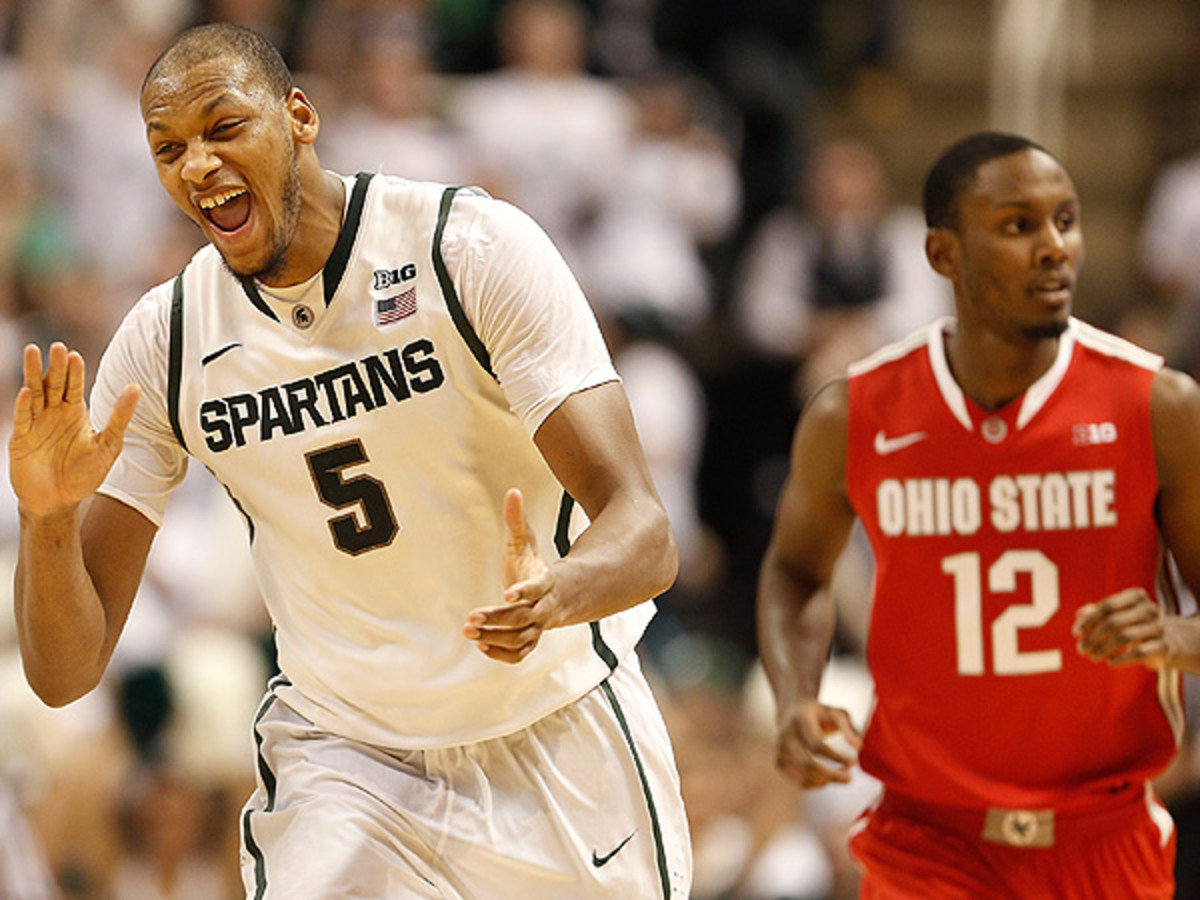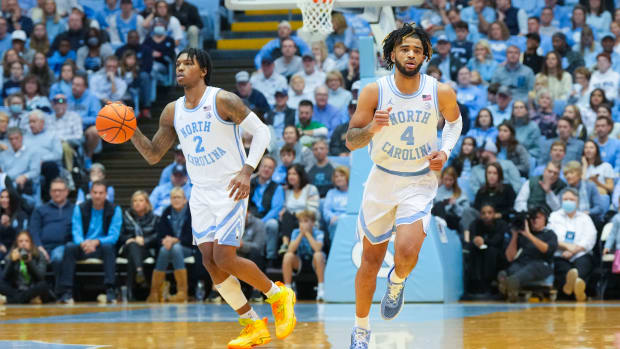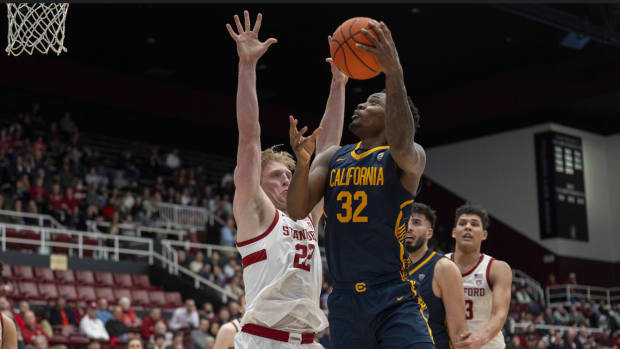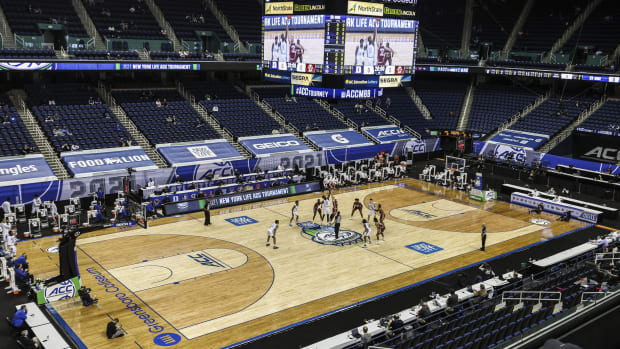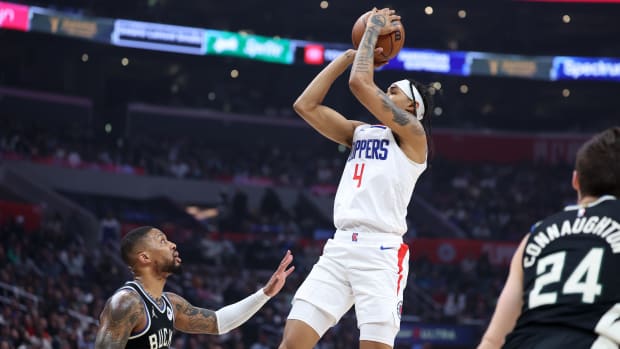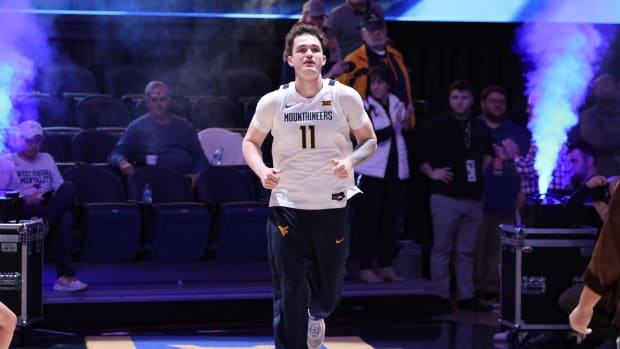The Halftime Show: Conference power rankings
Michigan State bolstered its Big Ten title chances by beating Ohio State on Jan. 7. (Gregory Shamus/Getty)
With interconference play (mostly) in the books until the postseason and leagues set to battle within their own ranks for the next two months, now is as good a time as any to sort out how they stack up in the national landscape. Here is a look at the country's top 10 conferences thus far and what to expect from them going forward:
1. Big Ten
Even with Michigan, last year's national runner-up and a preseason top 10 team, off to an unimpressive 10-4 start thanks in large part to Mitch McGary's back woes, the Big Ten - the nation's top conference for a few years now - looks as strong as ever. Into the Wolverines' national contender void has stepped Wisconsin, which has ridden bombs-away three-point shooting and a typically strong defense to a 15-0 start that included wins over Florida (at home), Saint Louis and West Virginia (in Cancun), and at Virginia. Ohio State, which was also undefeated (though only lightly tested) until dropping a heartbreaker in East Lansing, has made irrelevant concerns about the absence of a go-to scorer and the effects of new hand-checking rules by playing the nation's most efficient adjusted defense (per KenPom) anyway. Michigan State, despite seemingly its entire lineup being banged up, is the rare top five, 14-1 team that one can reasonably say has its best basketball ahead of it.
With a rising Iowa team (whose only losses were to now-top-10 teams Villanova and Iowa State away from home) just below the league's top tier and Illinois and Minnesota trying to sustain their encouraging starts, the Big Ten is a strong candidate to once again place more than half its teams into the NCAA tourney and lead the field in bids. And given how entertaining league play has been the last few seasons - not to mention already this season - getting to that point should be plenty of fun.
2. Big 12
The debate before the season was whether Oklahoma State - with Big 12 Player of the Year Marcus Smart, swingman Le'Bryan Nash, and underrated two-guard Markel Brown all returning - could be the first team since 2004 to deny Kansas at least a share of the conference title. Defeating Iowa State on Monday night helped the Jayhawks take an early lead toward another Big 12 crown. The highly entertaining Cyclones picked up a pair of nice home wins over Michigan and Iowa and knocked off a solid Boise State team in Hawaii, but it was their in-conference dismantling of Baylor -- themselves potentially a stronger team than expected -- that really made a statement.
The three-team race atop the Big 12 will be as entertaining as any league's, especially if the Cowboys can compensate for the loss of big man Michael Cobbins to a torn achilles. And while Kansas has been disappointing given the Wiggins-centric preseason hype, a look at their four losses -- to Villanova in the Bahamas, to Colorado and Florida in true road games, and most troublingly to San Diego State at home last weekend -- is a helpful reminder that they've played a downright brutal schedule. After all, among their nine wins are Duke (on a neutral floor), New Mexico, Georgetown and Toledo -- all likely tournament teams. Another team to keep an eye on is the Jayhawks' in-state rival: Kansas State (which has knocked off Gonzaga, Oklahoma State, and George Washington in the last month) looks like a much different team than the one that lost to Northern Colorado and Charlotte in November.
3. Pac-12
It was only 22 months ago that the Pac-12 sent just two teams - Colorado and California - to the NCAA tournament, where they were seeded 11th and 12th, respectively. (Cal was even placed in a play-in game, which it lost to South Florida.) But the Pac-12 of 2013-14 looks much more like the power conference it once was, particularly up top, where its best team doubles as the nation's. In Sean Miller's fifth season at the helm, Arizona holds a convincing No. 1 in the polls, undefeated through 17 games that included Duke in Madison Square Garden and San Diego State and Michigan on the road. The Wildcats, among the nation's best teams on both ends, have an elite one-and-done talent (Aaron Gordon), a leading scorer who doubles as a do-everything glue guy (Nick Johnson), and a heady, pass-first point guard running the show (T.J. McConnell). Aside from some experience, there is not much more Miller could ask for.
But what puts the Pac-12 first among a very hard-to-parse cluster of conferences in spots three through five are the challenges Arizona will get these next two months. Dana Altman's high-scoring Ducks will win more shootouts than they lose, and the Colorado team that knocked them off on Sunday proved their mettle by knocking off Kansas and Harvard and nearly doing the same to Oklahoma State. UCLA, which has broken the century mark three times already, can simply out-score teams too, while Cal, Utah, Stanford, and Jahii Carson-led Arizona State will all be in the tourney mix as well.
4. Big East
The new Big East, loss of so much storied tradition be damned, seems to be keeping alive the high-quality basketball long associated with its name. While preseason favorite Marquette trudges into conference play with a lackluster record to match its mediocre play thus far, several other teams have emerged as national players. Least surprising among them is Creighton, which may lack eye-grabbing pelts from non-conference play but nonetheless boasts the nation's most efficient scoring attack thanks to an array of high-percentage options and that All-America walk-on kid. It's Villanova, suddenly one of the nation's most trigger-happy teams from outside, that emerged as the Big East's most buzzworthy contender after beating Kansas and Iowa in the Bahamas over Thanksgiving weekend, and the Big East race will likely be heavily influenced by the outcome of the Wildcats' pair of meetings with the Bluejays. But with Grant Gibbs now sidelined at least four weeks with a dislocated kneecap and Doug McDermott nursing a sore shoulder, Creighton is limping in Big East play.
Lurking just behind that pair is an intriguing trio: Georgetown, which has neutral wins over Kansas State and VCU and two 16-point scorers at guard in D'Vauntes Smith-Rivera and Markel Starks; Butler, which nearly knocked off Villanova and Oklahoma State; and Xavier, which blew out Cincinnati last month and was on an 8-0 streak before losing to the Bluejays.
5. ACC
Timing can be cruel in exercises like this, and for the purposes of these rankings, the ACC is cold at precisely the wrong time. Just two of its teams are currently ranked in the AP poll: No. 2 Syracuse and No. 23 Duke, which recently fell out of the top 10 for the first time since 2007. Cuse is just doing its usual Cuse thing, shrugging off the departure of a lottery-pick point guard and four-year starting two by relying on another seasoned vet, forward C.J. Fair, and a couple next-men-up in breakout point guard Tyler Ennis and forward Jerami Grant. New conference, same story. Duke, enduring a brief funk as Jabari Parker reminds us he is mortal, has some concerns on the defensive end, but should climb back up the rankings soon enough.
Making sense of the rest of the ACC is more difficult. North Carolina, losers to Belmont and UAB and slayer of Michigan State and Louisville away from Chapel Hill, solidified their status as the nation's most enigmatic team by falling to Wake Forest. Virginia is pack-lining its way to another top-notch defense, but can't forge an offense to complement it. Pitt is 15-1, but its one loss, a 44-43 defeat against Cincinnati, was downright ugly and by far its biggest non-conference test. Notre Dame is now without leading scorer Jerian Grant due to academics. There is enough talent -- both in jerseys on the floor and in suits on the bench -- that the sprawling new-look ACC is likely to figure itself out soon, but as of now, there is too much mired in the middle to put it much higher than five.
Kentucky's question this season is what everyone expected: Can talent trump experience? (Andy Lyons/Getty)
6. SEC
Florida and Kentucky have struggled with their same respective issues all season. For Florida, getting the right players on the floor has been the problem -- Scottie Wilbekin, Casey Prather and Patric Young have all struggled with injuries. Transfer Damontre Harris was dismissed from the team and then subsequently welcomed back for next season; freshman Chris Walker is still in NCAA limbo. Kentucky's youth has been its problem, but it likely will be its solution as well as the season moves forward. But aside from these SEC East rivals, the conference is lacking top teams. Missouri, the third ranked team, got shocked by Georgia at home in its SEC opener, while Tennessee and LSU have have yet to put their promising talent into tourney-ready products. Arkansas, which claims Minnesota and Clemson as its best non-SEC wins, may be another team to watch, as are Marshall Henderson and Ole Miss -- though in their case, with home losses to Mercer and Dayton already dragging down their resume, the Rebels' role may be more of a spoiler.
7. American Athletic
For a league that relies on the strength of its top teams, the cannibalistic slide of UConn -- which lost consecutive road games to new conference-mates Houston and SMU to begin AAC play -- hurts more than it helps. The Huskies narrowly escaped Harvard at home to break their slide, but their lack of rebounding or any consistent interior presence and an offense over-reliant on Shabazz Napier's heroics will have them walking a tightrope on many nights. Last Thursday's result in Louisville -- where the Cardinals fell at home to Memphis -- illustrated that, post-Chane Behanan, the conference's top spot is very much up for grabs, especially with a stymieing Cincinnati team clamping down on opponents as well as just about any team in the country. Outside those four, the conference's best wins are Temple beating Saint Joseph's and South Florida over Alabama. In other words, slim pickings.
8. Atlantic 10
After losing its three marquee programs -- Xavier, Temple, and newcomer Butler -- to AAC poaching, this season was supposed to be a step back for the A-10. And while that may be true to an extent, the non-conference emergences of No. 19 UMass (which beat Clemson, New Mexico, and BYU) and George Washington (which beat Creighton, Maryland, Manhattan, and Miami) has given the conference a deeper stable of contenders than the two-team race between VCU and Saint Louis than anticipated. And don't count out Dayton, which offset losses to Illinois State and USC with neutral-site wins over Gonzaga and Cal. After the usual power-conference subjects, this looks like the nation's best league.
9. Mountain West
Steve Fisher once again has San Diego State making noise on the national stage -- most notably in snapping Kansas's 68-game non-conference home winning streak -- which has rightfully put him high on midseason coach of the year ballots. The gunners at Boise State and a New Mexico team, highlighted by the inside-outside combo of Cameron Bairstow and Kendall Williams, give the Mountain West two other strong contenders. But what's unusual for the conference this year is the lack of any clear tourney teams after the top three. UNLV came up short in its three biggest non-conference tests -- against Arizona, Arizona State, and Illinois -- and also dropped games to UC-Santa Barbara and the Mountain West's own Air Force. And though Utah State and Wyoming will compete, they aren't on the national radar.
10. West Coast
Missouri Valley
Dakota State
Gaels
